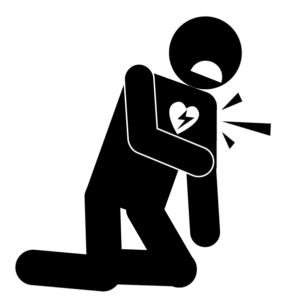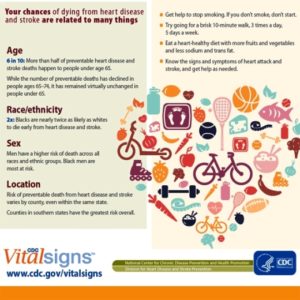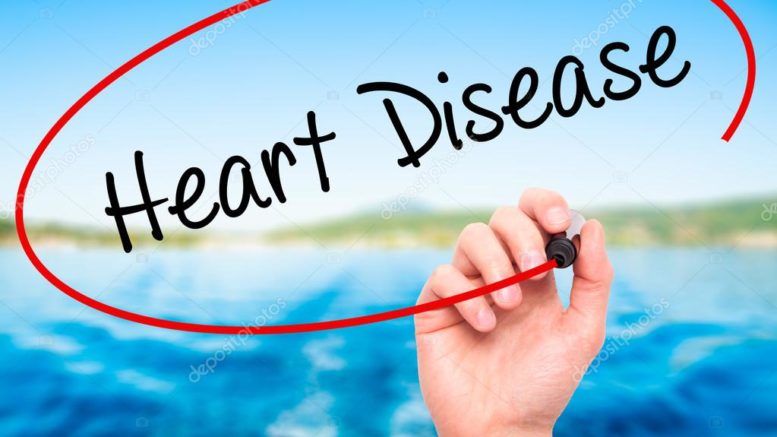What is heart disease?
Heart Disease includes a number of conditions which affect blood flow to and from the heart. One of the common heart conditions is myocardial infarction which is known as a heart attack.
What Is a Heart Attack?
A heart attack happens when the flow of oxygen-rich blood in one or more of the coronary arteries, which supply the heart muscle, suddenly becomes blocked, and a section of heart muscle can’t get enough oxygen.
When the heart muscle tissue is deprived of oxygen, that section of heart muscle begins to die.
Heart attacks are a leading killer of both men and women. Each year, more than 1 million people in the United States have a heart attack, and about half of them die. Half of those who die do so within 1 hour of the start of symptoms and before reaching the hospital.
A heart attack is an emergency. Learn the warning signs of a heart attack.
What are the signs and symptoms of a heart attack?
 Someone having a heart attack may experience only one, or several of these warning signs:
Someone having a heart attack may experience only one, or several of these warning signs:
- Crushing chest pain or chest discomfort. Most heart attacks involve discomfort in the center of the chest that lasts more than a few minutes, or that goes away and comes back. It can feel like uncomfortable pressure, squeezing, fullness or pain.
- Discomfort in other areas of the upper body. Symptoms can include pain or discomfort in one or both arms, the back, neck, jaw or stomach.
- Shortness of breath. May occur with or without chest discomfort.
- Other signs: These may include a cold sweat, nausea or lightheadedness.
What do I do if I am having a heart attack?
 A heart attack is an emergency. Call 9-1-1 immediately! You need to take an ambulance to the hospital as soon as possible. Do not try to drive yourself, and do not have someone else drive you unless there is no ambulance service where you live. The sooner you get to a hospital, the more emergency medical professionals can do to stop any heart damage and prevent deadly heart rhythm problems, heart failure, and death. If blood flow in the blocked artery can be restored quickly, permanent heart damage may be prevented. Yet, many people do not seek medical care for 2 hours or more after symptoms start.
A heart attack is an emergency. Call 9-1-1 immediately! You need to take an ambulance to the hospital as soon as possible. Do not try to drive yourself, and do not have someone else drive you unless there is no ambulance service where you live. The sooner you get to a hospital, the more emergency medical professionals can do to stop any heart damage and prevent deadly heart rhythm problems, heart failure, and death. If blood flow in the blocked artery can be restored quickly, permanent heart damage may be prevented. Yet, many people do not seek medical care for 2 hours or more after symptoms start.
The good news is that excellent treatments are available for heart attacks. These treatments—which work best when given right after symptoms occur—can save lives and prevent disabilities.
What are the risk factors for heart diseases?
 There are two types of risk factors:
There are two types of risk factors:
- Risk factors that you cannot do anything about them and
- Risk factors that you can do something about them
Risk factors that you cannot do anything about include:
- Age: About 4 out of 5 heart disease deaths are in people older than 65 years of age.
- Sex: Heart disease is more prevalent in men than in women, and men are at greater risk before age 65. Overall, men die from heart disease at a 60% higher rate than women.
- Race/Ethnicity: Heart disease is the number one cause of death nationally. African Americans die from heart disease at a 30% higher rate than whites, but American Indians, Asians, and Hispanics all die of heart disease at lower rates than whites.
- Family History: Several studies have shown that heart disease risk is increased for individuals with family members who have heart disease.
What are the risk factors for heart disease that can be changed?
- High Blood Cholesterol: Nearly 1 in 3 American adults has high cholesterol. Too much cholesterol puts you at risk for heart disease and stroke, two leading causes of death in the United States. High cholesterol has no signs or symptoms, so the only way to know if you have it is to get your cholesterol checked.
- High Blood Pressure: High blood pressure is a major risk factor for heart disease. About 69% of people who have a first heart attack have high blood pressure. Controlling hypertension (through increased physical activity, improved diet and nutrition, quitting smoking, and medications) is associated with a significant reduction in heart disease incidence.
- Cigarette Smoke: Smoking doubles to triples the risk of dying from coronary heart disease. In addition, over 35,000 non-smokers in the US die from coronary heart disease each year due to environmental exposure to tobacco smoke (passive smokers).
- Physical Inactivity: Physical inactivity increases the risk of heart disease anywhere from 1.5 to 2.4 times – comparable to the risk observed in high blood cholesterol, high blood pressure, or cigarette smoking. Physical activity can help you maintain a healthy weight and lower your blood pressure, cholesterol, and sugar levels. For adults, the Surgeon General recommends 2 hours and 30 minutes of moderate-intensity exercise, like brisk walking or bicycling, every week. Children and adolescents should get 1 hour of physical activity every day.
- Overweight and Obesity: A growing body of evidence is showing that heart disease risk increases with increased weight. Knowing your body mass index (BMI), achieving and maintaining a healthy weight, and getting regular physical activity are all actions you can take for yourself to combat obesity.
- Diabetes: The risk for heart disease is 2 to 4 times higher among people with diabetes. People with diabetes can lower their risk of heart disease by controlling their blood pressure and cholesterol levels.
Preventing Heart Disease: Healthy Living Habits
Choosing healthy meal and snack options can help you avoid heart disease and its complications. Be sure to eat plenty of fresh fruits and vegetables.
By living a healthy lifestyle, you can help keep your blood pressure, cholesterol, and sugar normal and lower your risk for heart disease and heart attack. A healthy lifestyle includes the following:
- Eating a healthy diet.
- Maintaining a healthy weight.
- Getting enough physical activity.
- Not smoking or using other forms of tobacco.
- Limiting alcohol use.

